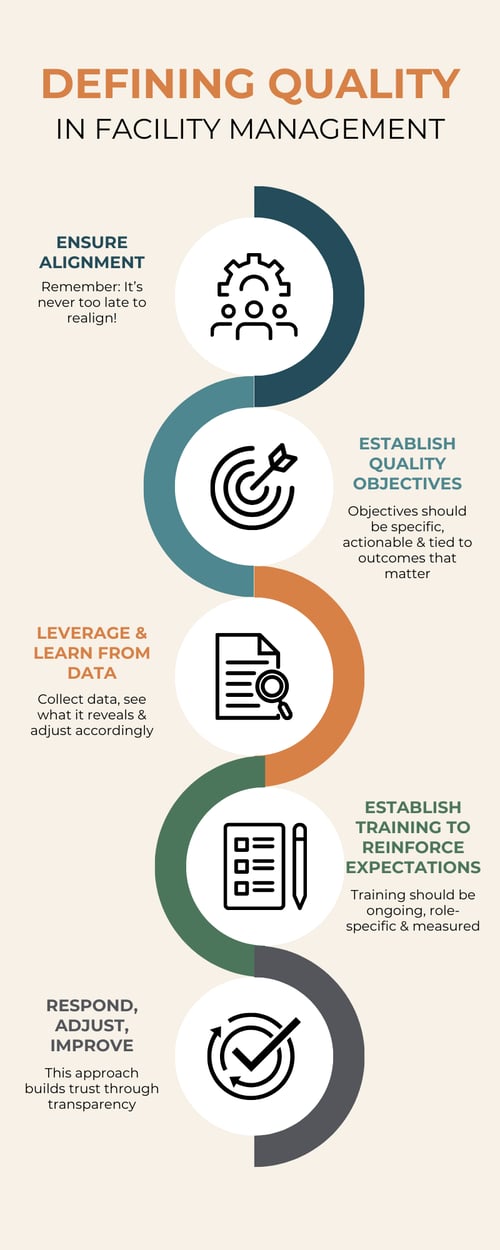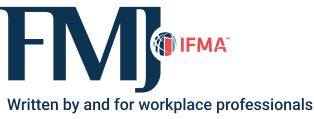Defining Quality
Proving the value through alignment

Facility managers know their work matters. But proving that value can be a challenge. Smooth operations and completed tasks only tell part of the story. If stakeholder expectations are not met, even excellent performance may go unnoticed.
 Ensure alignment
Ensure alignment
Defining quality internally is important for consistent service excellence. Because FM is often invisible until something goes wrong, success can be harder to quantify.
In a hospital, it might mean zero contamination. In manufacturing, it could mean uptime and compliance. In hospitality, it is seamless guest experiences.
Alignment requires FM leaders to ask early and often:
-
What are your goals?
-
What does success look like?
-
What challenges have you faced before?
When expectations shift, revisit the conversation. Realignment is never too late, and often, it is the key to being seen as a true partner.
Establish quality objectives
Once quality is defined, it must be translated into measurable objectives that connect operational performance to stakeholder priorities. These objectives might focus on compliance, efficiency, client satisfaction or team development. What matters is that they are specific, actionable and relevant.
Objectives should not remain static. Regular reviews and updates ensure performance management stays tied to outcomes that matter most. In this way, objectives become less about chasing abstract numbers and more about demonstrating reliability and impact.
Leverage & learn from data
Early on, it is important to set tentative goals that can be measured. These goals provide a starting point to track performance and improve over time.
Collect data, see what it reveals and adjust accordingly. This process should involve routine self-assessment, including internal audits and inspections, to proactively identify process inefficiencies and potential issues before they escalate.
Set a cadence of measurement that works for the operation, whether that is biweekly, monthly or quarterly. Without consistent measurement, self-assessment will not be effective.
Data is the tool that reveals whether expectations are being met, but it must be used wisely. Trends over time tell a more accurate story than isolated results.
Also, remember the importance of context: numbers do not always tell the full story, so it is important to investigate and learn the why behind what the data is saying.
If the data shows underperformance, learn and act. Ask questions like:
-
Is the goal realistic?
-
Is the process flawed?
-
Is there a training or resource gap?
-
Are external factors influencing results?
Whatever the challenge may be, adjust quickly and thoughtfully. The beauty of self-measurement is that it enables proactive improvement, not just reactive patches to cover problems.
Establish training to reinforce expectations
Even the best-designed process will fail without proper execution. That is why training is a cornerstone of quality.
Making learning and development a quality objective demonstrates a people-first commitment and reinforces a culture of continuous reinforcement.
Track metrics such as:
-
Training completion – Ensure team members are up to date on required learnings, procedures, and certifications.
-
Performance assessments – Ask: are individuals applying what they have learned?
-
Engagement and retention – These are strong indicators of team culture, which directly influences quality.
Training works best when it is ongoing, tailored to the responsibilities of each role, and measured not only by completion but by how confidently people apply what they have learned.
When training is prioritized this way, teams become more confident, more consistent, and more capable of delivering the level of service stakeholders expect.
Respond, adjust, improve
Even with clear quality objectives, a solid process of tracking and assessment and strong training, things can still go wrong.
If a quality issue arises, such as a non-conforming chemical being used in a sensitive area, act fast:
-
Contain the issue. Stop the process, quarantine the product, etc.
-
Communicate with stakeholders. Be transparent about happened and how the issue is being addressed and resolved.
-
Investigate the root cause.
-
Implement corrective actions. Address the root cause, not just the symptom.
-
Monitor progress. Check effectiveness over time to make sure the issue is truly resolved.
This structured approach to quality issues not only corrects the problem but also builds trust through transparency. Showing a thoughtful, accountable response is vital to earn stakeholder confidence.
Misalignment may still occur even without a clear incident. This may look like friction, confusion or dissatisfaction. In these cases, go back to the beginning:
-
Revisit stakeholder objectives, building alignment.
-
Re-evaluate quality objectives.
-
Leverage and learn from data.
-
Adjust quickly and thoughtfully.
-
Train team members.
Fostering a quality mindset
From the team lead to frontline associates, everyone has a role to play in the quality process. These four guiding principles help embed a quality mindset rooted in personal accountability:
-
Quality starts with me. Every task, no matter how small, contributes to the bigger picture. Personal accountability at every level sets the bar for success.
-
Verify Everything. Do not rely on assumptions. Understand procedures, scope of work, and stakeholder expectations. If something seems off, ask why. “Because we’ve always done it this way” is not a valid reason.
-
Check yourself. Go beyond compliance. Document actions, look for ways to improve, and promote taking pride in one’s work.
-
Challenge the status quo. Complacency is the enemy of quality. Use data, feedback, and curiosity to question processes and drive continuous improvement. What worked before may not be the best way to meet today’s expectations.
Conclusion
FMs do not “just” maintain buildings. They create experiences, protect people, enable productivity and support life-saving operations.
An FM at a medical device manufacturing plant may one day find themselves in an exam room with a loved one, hoping for a miracle from the same life-saving product they have worked around for years.
The connection is not always that clear, but quality matters. And “it starts with me.”
For FMs, that begins with defining quality, measuring what matters, and proving it, every day.

Read more on Performance & Quality or related topics Benchmarking , Training and Quality Improvement
Explore All FMJ Topics










